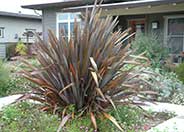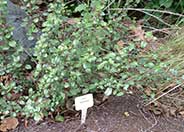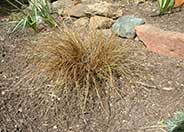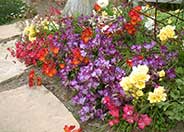

Common name:New Zealand Flax
Botanical name:Phormium tenax 'Atropurpureum'
Phormium tenax 'Atropurpureum' is an evergreen perennial. Big, dramatic plant composed of many swordlike, stiffly vertical leaves (9 ft. long, to 5 in. wide) in a fan pattern. Leaves are purple red. Flowers stems reach high above leaves, bearing clusters of 1-2 in. blossoms in dark red to yellow.

Common name:Evergreen Currant
Botanical name:Ribes viburnifolium
The evergreen currant is a fragrant evergreen shrub that grows 3-6 ft. tall and 6-10 ft. wide. It has red stems and small rose-colored flowers with red berries between February and April. This shrub tolerates moist conditions and needs partial shade inland. The evergreen currant is native to California and is drought tolerant.
-Cornflower Farms

Common name:Leather Leaf Sedge
Botanical name:Carex buchananii
This orange/bronze ornamental grass/reed is 2-3'H x 1-2' W and does best in full sun to part shade.

Common name:Freesia, Tecolote (strain)
Botanical name:Freesia X hybrida 'Tecolote H'ybrids
These perennials will grow 1-1.5' high and have slender, light green leaves. The plant produces double blooms in a variety of colors that are lightly fragrant. The variety shown is orange.
More than half of the water used at your home is for outside purposes. Studies show that on average, half of the water used outdoors is wasted. The leading cause of waste is incorrectly set and poorly managed irrigation controllers. The second biggest cause of wastage is broken irrigation equipment that goes undetected. There are a few basic things you can do to make a big difference in your water use.
Click in the green box for more information
| Designer: Turner Fine Gardens | Close up of Fairy Garden |
Photographer: GardenSoft |
Maintain a two to four inch layer of mulch on the soil surface to reduce weeds, infiltrate rain water, and reduce compaction.
Mulching and adding compost to soil can minimize evaporation and help soil absorb and store water.
Drip and other smart irrigation delivers water directly to roots, allowing no excess water for weeds.